Introduction
There are two types of mirrors – flat and curved. Flat mirrors are commonly used in homes while curved mirrors have specific applications in science and industry. Curved mirrors are classified into two types – concave and convex. The concave mirror has an inward curve and resembles a broken arc of a hollow sphere, while for the convex mirror, the reflecting surface is on the outside. Such special types of mirrors find widespread applications. For instance, when we need a wide-angle view, we can use convex mirrors and scientists can also use curved mirrors while designing telescopes and optical instruments.
Concave Mirror with Diagram and Formula
A concave mirror is curved inward on its inner reflecting surface and thus, you will see that it resembles the inside of a cave. The key parameters of concave mirrors are similar to those of a sphere, including the centre of curvature, the radius of curvature, the principal focus, and the focal length. To understand these terms better, take a look at the diagram below, which illustrates each of these parameters. We have shown the concave mirror detached from its parent sphere to aid in your understanding.

Concave mirror
Light rays coming from an object can reach the mirror one out of three ways:
- It can pass through the focal point and hit the mirror. In such a case, reflection makes it parallel to the principal axis.
- A light ray that crosses the centre of curvature before hitting the mirror will retrace the path it took initially.
- Light rays can also hit the mirror while travelling parallel to the principal axis. Such rays will cross the focal point of the lens after reflection.
- Finally, if a ray doesn’t satisfy either of the above two criteria, it will reflect from the mirror following the law of reflection, i.e., the angle of incidence will be the same as the angle of reflection.
Except for when the object is placed between the focal point and the pole of the mirror, concave mirrors produce a real and inverted image. Two possible ways of creating an image using this mirror are shown below:
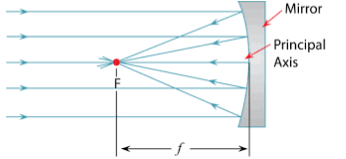
Concave mirror
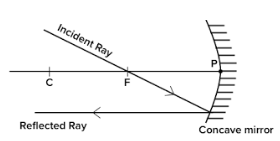
Concave mirror
One common example of the use of this mirror is in flashlights and torches, which use a concave mirror around the bulb, making the output beam parallel to the principal axis.
Example: For an object placed 90 cm from a concave mirror of focal length 30 cm. What is the distance at which the image will be formed?
It is a common norm to use u and v to represent the image and object distances, respectively. If f is the focal length of the mirror, then the mirror formula reads:

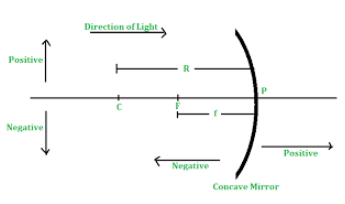
While performing measurements, certain sign conventions are followed. These are stated in the diagram below:
Hence, we have:
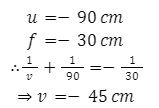
Thus, the image will be formed 45 cm towards the left side of the mirror.
Convex Mirror with Diagram and Formula
A convex mirror has a reflecting surface that is curved outward and is characterised by the same parameters as its concave counterpart. Thus, concepts like the centre of curvature, pole, radius of curvature, focus, etc. are present here as well and defined similarly. The mirror formula remains the same but the object distance is taken as positive since convex mirrors tend to form a virtual image towards the right side of the mirror. We can trace the light rays for a convex mirror just like a concave mirror.

Convex mirror ray tracing
The following properties may be noted for a convex mirror:
- A ray incident parallel to the principal axis will seem to emanate from the focal point.
- Light rays that fall on the pole of the mirror at an angle will be reflected on the other side of the principal axis at the same angle.
- A ray that seems to hit the centre of curvature of the mirror will not be deflected.
Characteristics Of Concave and Convex Mirror
Concave mirror
The images formed via a concave mirror can be seen in the diagram below, which illustrates the characteristics of this mirror. Objects placed in front of the mirror are represented in red while the images formed are represented in blue.
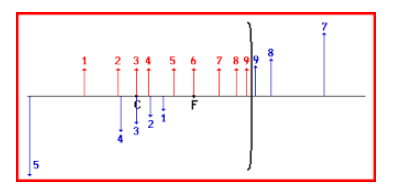
We can draw the following inferences:
- When the object is placed beyond the focal point of the mirror, a virtual image is formed behind the mirror.
- For an object placed at the focal point, no image is formed.
- For an object placed at the centre of curvature, an inverted image is formed at the centre of curvature itself.
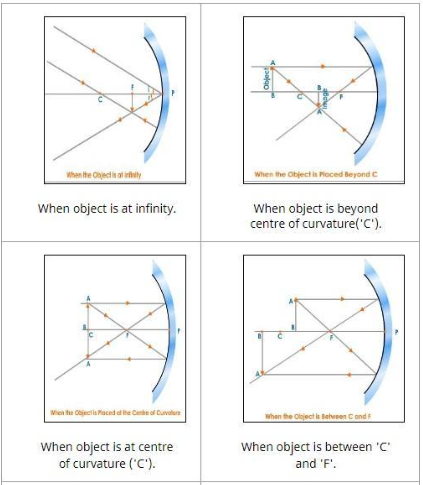

Concave mirror
Description: Different image characteristics for a concave mirror.
Convex mirror
Just as in the case of a concave mirror, we can perform similar analysis for a convex mirror as well. Ray Tracing allows us to determine how different objects will appear. Generally, a convex mirror forms virtual images.

Convex mirror
For a convex mirror, the images formed are virtual and thus impossible to project on a screen.
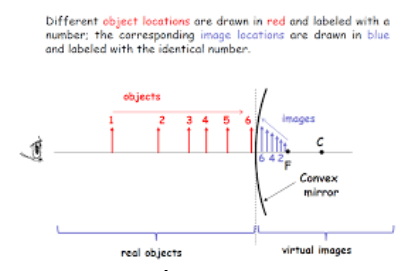
Convex mirror
Uses Of Concave and Convex Mirror
Uses of Concave Mirrors:
- Vehicle Headlights: Concave mirrors are used in vehicle headlights to direct the light from the bulb into a parallel beam, improving visibility on the road.
- Shaving and Makeup Mirrors: Concave mirrors provide a magnified and upright image when the object is placed within the focal length, making them ideal for close-up tasks like shaving or applying makeup.
- Ophthalmoscopes: Ophthalmologists use concave mirrors in ophthalmoscopes to examine the interior of a patient’s eye, including the retina and optic nerve.
- ENT Examination: Concave mirrors are used by ENT doctors to focus light into the patient’s ear, nose, or throat, making it easier to examine these areas.
- Solar Concentrators: Concave mirrors are used in solar concentrators to focus sunlight onto a small area, such as a solar cell or a heat-absorbing target, maximizing the energy collected.
Uses of Convex Mirrors:
- Rear-View Mirrors in Vehicles: Convex mirrors are used as rear-view mirrors in automobiles because they provide a wider field of view, allowing drivers to see more of the area behind the vehicle. However, objects appear smaller and farther away in a convex mirror, so caution must be exercised while judging distances.
- Security Mirrors: Convex mirrors are used in ATMs, retail stores, and other locations for security purposes. Their wide field of view allows surveillance of large areas with a single mirror, making it easier to monitor activity and spot potential security issues.
Difference Between Concave and Convex Mirror
Summary
With only slight differences in construction, concave and convex mirrors lead to vastly different images, which makes them quite interesting and useful in several applications. In this article, we discussed the various factors which were common across these two types of mirrors and showcased the diagrams, formulae, and uses of both. Further, we tabulated the differences in their properties and characteristics.
Frequently Asked Questions
1. What is magnification?
Magnification measures the increase or decrease in size of the image as compared to the size of the object. It is defined as the ratio of height of image to height of object.
2. What is the focal plane?
The focal plane is defined as that plane which lies perpendicular to the principal axis and passes through the focal point of the lens.
3. What is aperture?
The aperture measures the size of the mirror, and it is the diameter of the mirror itself.
4. What happens when an object is taken farther away from a concave mirror?
For a concave mirror, the image size becomes smaller and smaller as the object is pulled farther and farther from the mirror.
5. What does the value of magnification indicate?
The sign of magnification can tell us whether the image is erect or inverted. Further, its magnitude is greater than 1 if the image is magnified or less than 1 if diminished.
 Mission Statement
Mission Statement
“Empower every student to achieve full potential”
88Guru has been established with the social objective of making quality video-based learning material available to all Indian students. Technology, Connectivity and Social Media are rapidly changing the world of Education and we wish to lead the transformation of the tuition industry in India.
88Guru is the perfect complement to the current tuition model. 88Guru creates a wonderful opportunity for children and parents to bond while engaging in a valuable learning activity. It also provides the complete curriculum at your fingertips for those moments when you need some help at short notice. We believe that this mode of tuition could be transformational, adding hours to a child's day while providing complete control over the learning process.
Every course is taught by the best teachers from India's top schools and conducted in an engaging manner to keep students involved. The e-learning process consists of video-based instructions, computer-graded assignments, and a dashboard which allows the student and parent to track progress.




